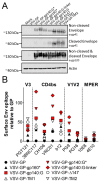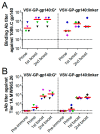Induction of Tier 1 HIV Neutralizing Antibodies by Envelope Trimers Incorporated into a Replication Competent Vesicular Stomatitis Virus Vector
- PMID: 30769947
- PMCID: PMC6409518
- DOI: 10.3390/v11020159
Induction of Tier 1 HIV Neutralizing Antibodies by Envelope Trimers Incorporated into a Replication Competent Vesicular Stomatitis Virus Vector
Abstract
A chimeric vesicular stomatitis virus with the glycoprotein of the lymphocytic choriomeningitis virus, VSV-GP, is a potent viral vaccine vector that overcomes several of the limitations of wild-type VSV. Here, we evaluated the potential of VSV-GP as an HIV vaccine vector. We introduced genes for different variants of the HIV-1 envelope protein Env, i.e., secreted or membrane-anchored, intact or mutated furin cleavage site or different C-termini, into the genome of VSV-GP. We found that the addition of the Env antigen did not attenuate VSV-GP replication. All HIV-1 Env variants were expressed in VSV-GP infected cells and some were incorporated very efficiently into VSV-GP particles. Crucial epitopes for binding of broadly neutralizing antibodies against HIV-1 such as MPER (membrane-proximal external region), CD4 binding site, V1V2 and V3 loop were present on the surface of VSV-GP-Env particles. Binding of quaternary antibodies indicated a trimeric structure of VSV-GP incorporated Env. We detected high HIV-1 antibody titers in mice and showed that vectors expressing membrane-anchored Env elicited higher antibody titers than vectors that secreted Envs. In rabbits, Tier 1A HIV-1 neutralizing antibodies were detectable after prime immunization and titers further increased after boosting with a second immunization. Taken together, VSV-GP-Env is a promising vector vaccine against HIV-1 infection since this vector permits incorporation of native monomeric and/or trimeric HIV-1 Env into a viral membrane.
Keywords: 1086.C HIV-1 Env; HIV vaccine; VSV-GP viral vaccine vector; broadly neutralizing antibodies; vesicular stomatitis virus.
Conflict of interest statement
D.v.L. is an inventor of VSV-GP and held minority shares in the biotech company ViraTherapeutics GmbH, which holds the intellectual property rights for VSV-GP. For the other authors, no competing financial interests exist. The funders had no role in the design of the study; in the collection, analyses, or interpretation of data; in the writing of the manuscript, or in the decision to publish the results.
Figures






Similar articles
-
A Trimeric HIV-1 Envelope gp120 Immunogen Induces Potent and Broad Anti-V1V2 Loop Antibodies against HIV-1 in Rabbits and Rhesus Macaques.J Virol. 2018 Feb 12;92(5):e01796-17. doi: 10.1128/JVI.01796-17. Print 2018 Mar 1. J Virol. 2018. PMID: 29237847 Free PMC article.
-
Heterologous Combination of VSV-GP and NYVAC Vectors Expressing HIV-1 Trimeric gp145 Env as Vaccination Strategy to Induce Balanced B and T Cell Immune Responses.Front Immunol. 2019 Dec 18;10:2941. doi: 10.3389/fimmu.2019.02941. eCollection 2019. Front Immunol. 2019. PMID: 31921191 Free PMC article.
-
Conformational Epitope-Specific Broadly Neutralizing Plasma Antibodies Obtained from an HIV-1 Clade C-Infected Elite Neutralizer Mediate Autologous Virus Escape through Mutations in the V1 Loop.J Virol. 2016 Jan 13;90(7):3446-57. doi: 10.1128/JVI.03090-15. J Virol. 2016. PMID: 26763999 Free PMC article.
-
Development of an HIV vaccine using a vesicular stomatitis virus vector expressing designer HIV-1 envelope glycoproteins to enhance humoral responses.AIDS Res Ther. 2017 Sep 12;14(1):55. doi: 10.1186/s12981-017-0179-2. AIDS Res Ther. 2017. PMID: 28893277 Free PMC article. Review.
-
[Requirements for the Induction of Broadly Neutralizing Antibodies against HIV-1 by Vaccination].Mol Biol (Mosk). 2017 Nov-Dec;51(6):945-957. doi: 10.7868/S0026898417060076. Mol Biol (Mosk). 2017. PMID: 29271959 Review. Russian.
Cited by
-
Viral Vectors for the Induction of Broadly Neutralizing Antibodies against HIV.Vaccines (Basel). 2019 Sep 19;7(3):119. doi: 10.3390/vaccines7030119. Vaccines (Basel). 2019. PMID: 31546894 Free PMC article. Review.
-
Characterization of the Anti-Viral and Vaccine-Specific CD8+ T Cell Composition upon Treatment with the Cancer Vaccine VSV-GP.Vaccines (Basel). 2024 Aug 1;12(8):867. doi: 10.3390/vaccines12080867. Vaccines (Basel). 2024. PMID: 39203993 Free PMC article.
-
RSV Vaccine Based on Rhabdoviral Vector Protects after Single Immunization.Vaccines (Basel). 2019 Jul 3;7(3):59. doi: 10.3390/vaccines7030059. Vaccines (Basel). 2019. PMID: 31277325 Free PMC article.
-
Engineering of Live Chimeric Vaccines against Human Metapneumovirus.Pathogens. 2020 Feb 19;9(2):135. doi: 10.3390/pathogens9020135. Pathogens. 2020. PMID: 32093057 Free PMC article. Review.
-
Potency and durability of T and B cell immune responses after homologous and heterologous vector delivery of a trimer-stabilized, membrane-displayed HIV-1 clade ConC Env protein.Front Immunol. 2023 Nov 17;14:1270908. doi: 10.3389/fimmu.2023.1270908. eCollection 2023. Front Immunol. 2023. PMID: 38045703 Free PMC article.
References
-
- UNAIDS . Global Aids Update. UNAIDS; Geneva, Switzerland: 2016.
-
- Mascola J.R., Lewis M.G., Stiegler G., Harris D., VanCott T.C., Hayes D., Louder M.K., Brown C.R., Sapan C.V., Frankel S.S., et al. Protection of macaques against pathogenic simian/human immunodeficiency virus 89.6pd by passive transfer of neutralizing antibodies. J. Virol. 1999;73:4009–4018. - PMC - PubMed
Publication types
MeSH terms
Substances
LinkOut - more resources
Full Text Sources
Research Materials

